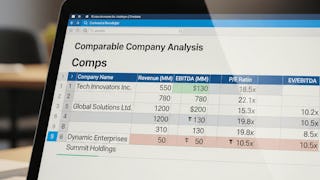This course equips learners with the knowledge and analytical skills to interpret, calculate, evaluate, and apply key concepts in comparable company valuation (COMPS). Beginning with the foundations of enterprise value and extending through debt and equity adjustments, share price insights, and balance sheet interpretation, participants will analyze profitability metrics, compute growth measures, assess sector-specific performance, and implement advanced valuation techniques such as LTM calculations, calendarization, and currency management.



Comparable Company Valuation – Core Concepts & Methods

Instructor: EDUCBA
Access provided by ExxonMobil
Skills you'll gain
- Cash Flows
- Financial Statements
- Working Capital
- Financial Data
- Financial Accounting
- Financial Statement Analysis
- Market Share
- Performance Analysis
- Operational Efficiency
- Business Valuation
- Balance Sheet
- Equities
- Benchmarking
- Financial Forecasting
- Competitive Analysis
- Capital Expenditure
- Business Metrics
- Gross Profit
- Financial Modeling
- Financial Analysis
Details to know

Add to your LinkedIn profile
14 assignments
September 2025
See how employees at top companies are mastering in-demand skills

There are 4 modules in this course
This module provides learners with a comprehensive foundation in comparable company analysis (COMPS) and enterprise value (EV) concepts. It covers the identification and application of trading and transaction comparables, detailed calculation of enterprise value, and integration of debt, net debt, and share-related considerations. Learners will explore how to incorporate pension and lease obligations, determine cash and cash equivalents, and refine net debt calculations. The module emphasizes accurate financial adjustments, ensuring participants can apply real-world valuation methods with precision.
What's included
11 videos3 assignments
This module develops learners’ ability to evaluate advanced share components and financial assets within the context of company valuation. It covers the accurate calculation of basic shares outstanding, application of currency conversions for cross-border analysis, identification of financial assets, and the relationship between revenue, share prices, and trading comparables. By the end of this module, learners will be able to integrate these components into a consistent, comparable framework for valuation purposes.
What's included
8 videos3 assignments
This module equips learners with the skills to interpret and adjust key financial metrics from consolidated financial statements. It covers the calculation of total assets, the role of non-controlling interest, and verification of adjusted financial figures. Learners will also explore adjusted earnings measures, including adjusted EPS and adjusted operating profit, and analyze cash flows from investing activities. Emphasis is placed on integrating these metrics into accurate, comparable valuation models.
What's included
8 videos3 assignments
This module guides learners through the analysis of profitability, growth metrics, sector-specific performance evaluation, working capital adjustments, and advanced valuation techniques such as LTM calculations and calendarization. It explores how to interpret sector examples, measure operational efficiency, calculate adjusted growth rates, and manage currency fluctuations for multinational financial analysis. By the end of the module, learners will be able to align financial periods, assess operational metrics, and apply calendarized and currency-adjusted data to comparable company analysis.
What's included
24 videos5 assignments
Why people choose Coursera for their career









